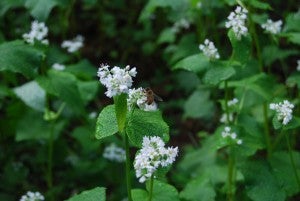The harvest season is ending, but for many growers concerned about the health of their soil, it is time to plant cover crops. I am not a farmer, but I wondered: if cover crops work for farmers, would they improve the soil in my North Carolina kitchen garden?
So late this summer I planted a buckwheat cover crop on half of my garden. I’ll be honest. My record as a gardener is spotty. This year we had a bounty of tomatoes and volunteer pumpkins, while nothing else thrived. A cover crop could improve my soil and my harvest next summer.
Cover crops offer big benefits
On farms, cover crops include grasses and grains such as cereal rye, legumes such as crimson clover, and broadleaf plants like radishes. They are not harvested like corn or soybeans. Instead, they are left in the field or incorporated into the soil.
There are many environmental benefits of planting cover crops.
- They prevent nutrient loss by scavenging excess fertilizer from the soil and holding it for the next crop. Studies show that cover crops reduce nitrogen loss by 13 to 94 percent and phosphorus loss by 54 to 92 percent.
- They reduce soil erosion by water and air.
- They increase organic matter in the soil.
Cover crops can even increase the yields of the crops that follow them – and put more money in growers’ pockets.
Results from a 2012-2013 cover crop survey conducted by the Conservation Technology Information Center reported that corn yields planted on fields after cover crops increased 10 percent and soybean yields increased by 11 percent, compared to adjacent fields with no cover crops.
 Growers are slow to plant cover crops
Growers are slow to plant cover crops
Despite the environmental and economic benefits, most farmers do not plant cover crops. For example, farmers in the fertile Mississippi River Basin grow cover crops on less than two percent of total cropland.
Barriers to adoption include lack of knowledge about benefits, the costs of seed, and the time and labor involved in managing the crops.
Goal: Remove the barriers, increase adoption
In the Southeast United States, EDF is collaborating with Smithfield Foods, the largest pork producer in the world, to promote cover crop adoption to grain farmers in their grain sourcing region. Growers will have the opportunity to work with a trained agronomist to remove barriers by providing education and technical assistance in selecting, planting and managing cover crops.
I am proud to report that my cover crop has grown knee-high, and its abundant flowers are attracting bees from our hives and other native pollinators. Plus, the buckwheat is providing nectar for the bees during a gap in the season when other plants are not flowering.
It’s clear to me that increasing the use of cover crops provides critical benefits to farmers and the environment that extend far beyond my own small garden.










